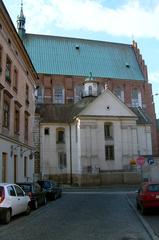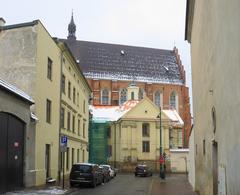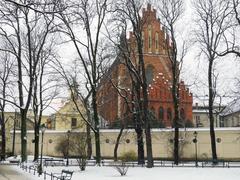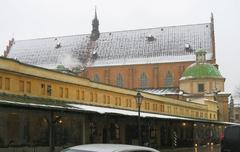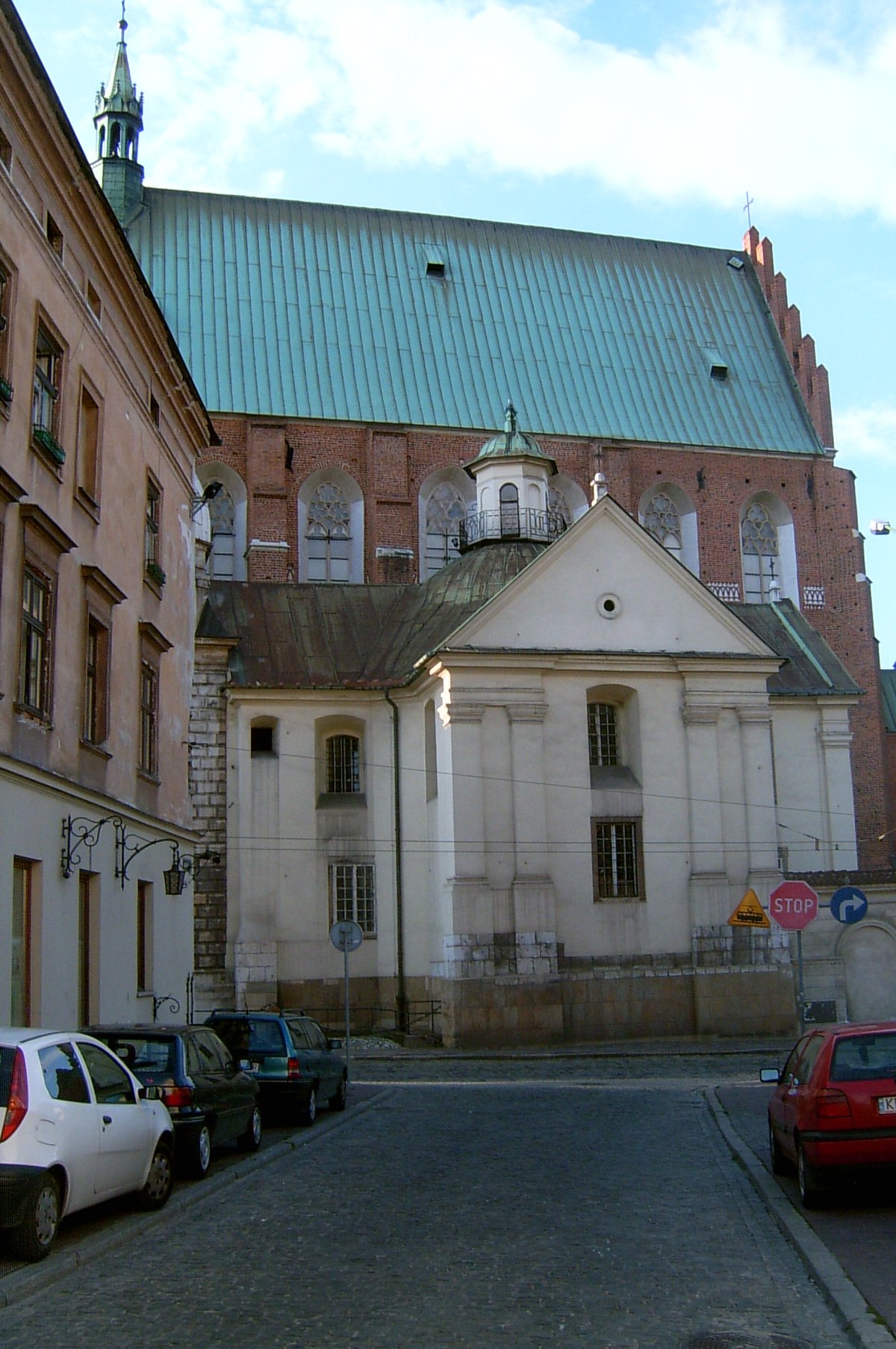
Basilica of the Holy Trinity Kraków: Visiting Hours, Tickets, and Complete Travel Guide
Date: 14/06/2025
Introduction
Rising majestically in Kraków’s Old Town, the Basilica of the Holy Trinity is one of Poland’s most significant Gothic monuments. With a history stretching over 800 years, this basilica stands as both a spiritual sanctuary and a testament to the city’s resilience through fires, invasions, and periods of reconstruction. Founded by the Dominican Order in the early 13th century, its walls have witnessed pivotal moments in Polish religious and cultural life. Today, visitors can explore its unique blend of Romanesque and Gothic architecture, venerate the tomb of Saint Hyacinth, and experience a living tradition that continues to shape Kraków’s identity.
This guide offers a thorough overview of the basilica’s history, architecture, visitor information—including hours, ticketing, accessibility, and tips—and its role as both a spiritual and cultural landmark. Whether you are a pilgrim, history lover, or curious traveler, this resource will help you plan a meaningful visit to one of Kraków’s most iconic sites. For up-to-date details, refer to the basilica’s official website and the Kraków Tourism Board. (medievalheritage.eu, Visit Małopolska, Wikipedia)
Table of Contents
- Introduction
- Historical Overview
- Visitor Information
- Religious and Cultural Significance
- Notable Historical Events
- Frequently Asked Questions (FAQ)
- Plan Your Visit
- Conclusion
- References
Historical Overview
Origins and Foundation
The basilica’s origins trace to 1222, when Bishop Iwo Odrowąż brought the Dominican Order to Kraków from Bologna. The order was granted Kraków’s original parish church, which was soon re-consecrated as a monastic church. Despite early setbacks—including a devastating fire in 1225 and the destruction of the friary during the Mongol invasion of 1241—the Dominicans, bolstered by noble and ecclesiastical support, quickly rebuilt their complex. (medievalheritage.eu)
Medieval Expansion and Architectural Evolution
Rebuilding and Gothic Flourishing
Reconstruction in the mid-13th century introduced early Gothic features, including brick cloisters and a new stone refectory. Papal indulgences in 1248 and 1251 fueled further construction, culminating in the completion of the nave and the burial of Saint Hyacinth by 1257. The Gothic chancel, one of Europe’s earliest long choirs, became the resting place of Prince Leszek the Black in 1289, marking the basilica’s growing prominence.
Transformation and Enhancements
By the early 14th century, the church evolved from a pseudobasilica to a true basilica, with architectural advancements like the pillar-buttress system. Subsequent centuries saw further modifications—raising chancel walls, re-vaulting after fires, and expanding friary buildings. By the late 15th century, the basilica had achieved much of its present Gothic form. (medievalheritage.eu)
Fires, Destruction, and Rebuilding
The basilica’s resilience is epitomized by its survival and restoration after a series of calamities, most notably the great fire of 1850, which destroyed much of the interior. The Dominicans rebuilt the church, culminating in the neo-Gothic porch addition in 1876. These efforts preserved key medieval elements, including the Romanesque refectory and the late Gothic vestibule. (medievalheritage.eu)
Visitor Information
Visiting Hours
The Basilica of the Holy Trinity is generally open daily. As of June 2025, typical hours are from 7:00 AM to 7:00 PM, though these may vary on religious holidays or during special events. Always confirm current hours on the official website.
Tickets and Admission
Entry is free, reflecting its active role as a house of worship. Guided tours and access to certain exhibitions or crypts may require a modest fee, bookable online or onsite.
Guided Tours
Tours are available in multiple languages and offer deep insight into the basilica’s history, art, and spiritual heritage. Booking ahead is recommended during peak seasons.
Accessibility
The basilica offers step-free access and adapted restrooms. Some chapels and crypts may be less accessible due to steps or uneven floors; contact the visitor center for assistance or specific needs.
Travel Tips
- Located in Kraków’s Old Town, the basilica is easily reached on foot or by public transport.
- Photography without flash is permitted, except during services or in restricted areas.
- Modest attire (covered shoulders and knees) is expected.
Religious and Cultural Significance
As Kraków’s principal Dominican church, the basilica has been central to the city’s religious, educational, and charitable activities since the 13th century. It houses the revered tomb of Saint Hyacinth, a focal point for pilgrimages, especially on his feast day, August 17. The sanctuary of Our Lady of the Rosary attracts devotees, particularly during the annual Feast of Our Lady of the Rosary on October 8, featuring special liturgies and processions. (Visit Małopolska)
The basilica’s evolving architecture—Romanesque, Gothic, and neo-Gothic—mirrors the broader course of Polish sacred art. Its chapels, stained glass, and liturgical objects are celebrated examples of ecclesiastical artistry.
Notable Historical Events
- 1241: Mongol invasion destroys the friary, sparking major rebuilding.
- c. 1257: Burial of Saint Hyacinth marks completion of key construction phases.
- 1289: Prince Leszek the Black interred in the chancel.
- 1462: Fire leads to major chancel reconstruction.
- 1850: Great fire devastates the basilica; 19th-century rebuilding follows.
Frequently Asked Questions (FAQ)
Q: What are the current visiting hours?
A: The basilica is generally open daily from 7:00 AM to 7:00 PM, but hours may change for holidays or special events. Check the official website for updates.
Q: Is there an entrance fee?
A: General entry is free; guided tours and special exhibitions may require a ticket.
Q: Are guided tours available?
A: Yes, in multiple languages. Reserve in advance, especially during busy periods.
Q: Is the basilica accessible for visitors with disabilities?
A: Most areas are accessible. Some chapels and crypts may have limited access.
Q: Can I attend Mass?
A: Yes, daily Masses and major liturgical celebrations are open to the public.
Q: Can I take photographs inside?
A: Non-flash photography is allowed except during services or in restricted areas.
Plan Your Visit
For the most current visitor information, tour options, and event schedules, consult the official Basilica website and the Kraków Tourism Board.
Explore other Kraków highlights nearby, including Wawel Castle, St. Mary’s Basilica, and the Church of SS Peter & Paul, for a comprehensive Old Town experience.
Conclusion
The Basilica of the Holy Trinity is a cornerstone of Kraków’s spiritual and cultural heritage. Its architecture, history, and ongoing religious life invite both reflection and admiration. Free admission, welcoming facilities, and a central location make it accessible to all. Whether drawn by faith, history, or art, visitors will find an experience that resonates long after they leave.
Plan ahead, check current visiting hours, and consider a guided tour to deepen your appreciation of this extraordinary Kraków historical site.
Images include alt tags such as ‘Basilica of the Holy Trinity Kraków’ and ‘Kraków historical sites’ for optimal accessibility and SEO.
Related Articles
- Top Historical Churches to Visit in Kraków
- Guide to Kraków Old Town Attractions
- Exploring Gothic Architecture in Poland
References
- Basilica of the Holy Trinity in Kraków: medievalheritage.eu
- Basilica of the Holy Trinity information: Visit Małopolska
- Wikipedia entry on the basilica: Wikipedia
- Visitor guide: In Your Pocket Krakow
